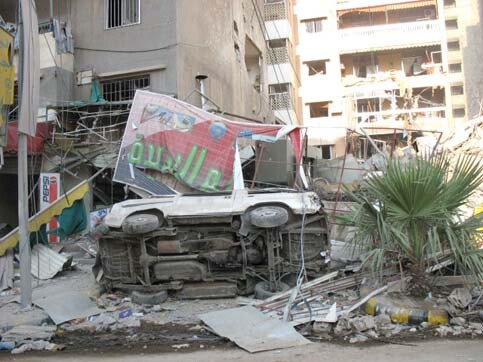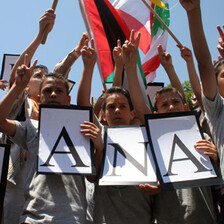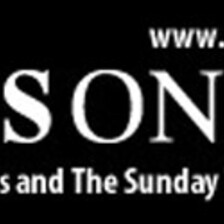Electronic Lebanon 16 August 2006

The devastation of 34 days of Israeli bombing of the southern suburbs of Beirut, August 15, 2006. (IRIN/Marie-Claire Feghali)
During Israel’s war against the people of Lebanon, our media, politicians and diplomats have colluded with the aggressors by distracting us with irrelevancies, by concocting controversies, and by framing the language of diplomacy. In the fragile truce that is currently holding while Lebanon waits for Israel to withdraw, we are simply getting more of the same.
One example of the many distractions during the war that neatly reveals their true purpose is the “faked Reuters photograph” affair. The supposed scandal of a Lebanese photographer tampering with a picture to add and darken smoke from an Israeli missile attack — to little or no effect, it should be noted — has not only been decried by activists on Zionist websites but amplified by mainstream commentators into a debate about whether we can trust the images of this war.
Who benefits from these doubts? If we cannot be sure that this one photograph is genuine, then maybe many more that purportedly show some of the 1,000 Lebanese civilians killed by Israel’s bombardment are fake too. Maybe the dead have been airbrushed in as easily as a puff of smoke. Maybe too, were the smoke removed, we would still be able to see that Israel has “the most moral army in the world”.
The far worse photography scandal, which is not talked about, is that the images of the war we saw over the past month in our Western media were constantly doctored, day in, day out. Not by ordinary photographers who risk their lives, and hope to make their fortunes, conveying the reality of war, but by the senior executives of newspapers and TV stations who ensure we are never presented with that reality. Pictures were binned or cropped if they hinted at what suffering and death truly looked like. Western audiences were not shown the row of charred corpses lying in the street, or the agony of a son pressing a scrap of cloth to the severed arm of his mother as she bled to death, or the crushed baby pulled from the rubble.
Our news and picture editors say this is about good taste. They justify their decisions on the grounds that we should not exploit the victims of war by showing pornographic images of their death — a useful excuse as we can never know what the dead would have chosen. More significantly, however, the exclusion of meaningful images of the human cost of war protects us from understanding the appalling consequences of Israel’s military actions, an onslaught sanctioned and supported by our Western media, politicians and diplomats, and indirectly by our taxes.
How long would Israel’s war have been allowed to continue if American audiences had seen those charred bodies or dead babies? How long would most Western viewers have remained silent if they were exposed to the kind of images shown daily on the Arabic satellite channels? Might we then start to understand why they hate us — and more usefully why we should hate ourselves?
Much the same purpose has been satisfied in the diplomatic arena by the endless debates about whether Israel’s offensive was “disproportionate” — a word that raises a yawn almost the second it is uttered — rather than whether it was necessary. And by the controversy initiated by the United Nations’ Jan Egeland about the “cowardly blending” of Hizbullah fighters among Lebanese civilians, a comment he made while in Jerusalem, not Beirut, based on evidence he has never divulged. It is truly astonishing that the world’s representative on humanitarian affairs made most impact in this war — one in which more than 1,000 Lebanese were killed and in which hundreds of thousands more were made homeless — trying to hold Hizbullah to account for the thousands of Israeli air strikes on civilian areas of Lebanon. Such is the upside-down logic and morality of our leaders.
And we are in the same territory again with the current discussions about how Lebanon and Israel will be rebuilt after the fighting. Reconstruction — another word that provokes instant boredom — fits the bill perfectly: both nations, we are told, will need billions of dollars to repair the damage done to their infrastructure. The story of astronomical losses conveys reassuringly to us a sense both of technical problems that will eventually be solved and of the ultimate symmetry and justice in the suffering of these two nations. Both peoples face a terrible financial burden imposed by war, both are equally deserving of our sympathy.
But let us pause. How precisely are these two nations’ material losses equivalent? Israel’s derive mostly from the enormous costs of its attacks on Lebanon, the tens of thousands of missiles fired into its towns and villages, that killed mostly civilians, and damage to the tanks, helicopters and warships that were the machinery needed to invade another sovereign country. Most of the rest of the cost will follow from losses in tourism revenue and investment, the consequences of a fall in confidence caused by Israel waging an unnecessary war for the return of two soldiers captured by Hizbullah rather than engage in negotiations. A small share of Israel’s lost billions has been inflicted by the aggression of Hizbullah.
The material damage done to Lebanon is in a different category altogether. The bombed roads and bridges, the tens of thousands of homes in ruins, the destroyed power stations, factories and petrol stations, the oil slick across much of the Lebanese coast are the direct result of Israel’s campaign of precision bombing of Lebanese civilian infrastructure.
Think of how your local court might consider the respective claims of these two nations if this were a domestic dispute between neighbours. Would a judge view with any sympathy a claim from a man demanding compensation from his neighbour for the damage done to his expensive sledgehammer after a destructive rampage through the neighbour’s home, as well as for the loss of his reputation that followed the attack, as he found himself cast as the neighbourhood pariah? Would it make any difference if it could be proved that his neighbour had sworn provocatively at him before he went on his rampage?
Incredibly, a similar claim may yet be heard — and possibly sympathetically — by the US civil courts if Israeli lawyers succeed in bringing a case for damages against the Lebanese government.
But all of this, like the “faked photograph affair”, is another layer of distraction. The real issue that should be the most pressing matter at the top of the world’s agenda is not an assessment of the mutual crimes against property but the mostly one-sided crimes against human beings — the massive Israeli war crimes that have been committed throughout the past month in Lebanon, whose effects will continue as cluster bombs blow up returning refugees, and are still being committed every day against the Palestinians of Gaza and the West Bank.
This urgent moral case is being quietly overlooked in favour of the material damages story, and for reasons not hard to discern. Because if we concentrated on the tally of war crimes, Israel would come out the undoubted winner in both Lebanon and Gaza.
Jonathan Cook, based in Nazareth, is the author of Blood and Religion: The Unmasking of the Jewish and Democratic State, published by Pluto Press and available in the US from University of Michigan Press. His website is www.jkcook.net.
Related Links





